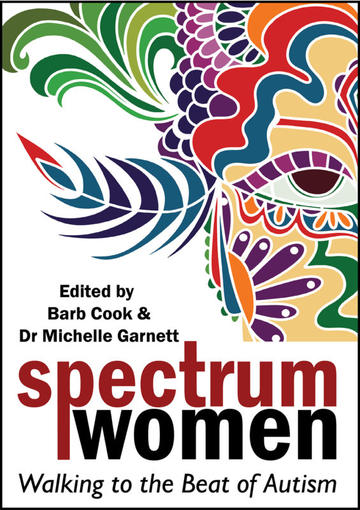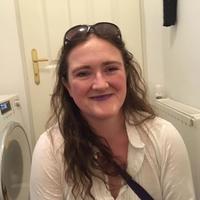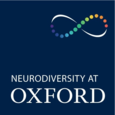Spectrum Women: Walking to the Beat of Autism
Spectrum Women: Walking to the Beat of Autism

With a 20-chapter book, it would be unwise to discuss each chapter in depth. In this review I try to take an overview of the book, the topics it tackles, the repeating themes, and the approach of contributors. This is not an academic review, but a reflection on the book’s style and content, and on the experience of reading it. Each chapter is short, typically 13-16 pages, and all read easily, without excessive technical jargon or dense prose. I am very glad to have read it and would urge others interested in autistic women’s experiences to do the same, but cautiously, with a few caveats in place.
The authors are unashamed in tackling difficult and sensitive topics. There are chapters dealing with areas such as abuse, addiction, health, and hygiene, and authors are frank and open in discussions of their personal experiences. A content warning at the start flags how raw some chapters are to readers, and each chapter is written compassionately and non-judgementally, the personal voice giving readers a chance to identify with authors, and / or learn from them, without being overwhelmed.
Some chapters are co-written. It isn’t always easy to tell where the switch between voices lies within a chapter, and this can make it hard to follow through reading ‘with’ the authors. The strength of relationship between the whole group is evident, however: 15 women, 20 chapters, and a preface which couches the whole volume in terms of group coherence. The book is couched in terms of empowering autistic women in a mentoring framework, addressing topics, answering questions, and creating road maps for approaching life which autistic women might have lacked.
This is very powerful, and for a community such as Oxford, the representation of academic women is important: autistic women exist and do flourish in academia. The tension between realising, validating and accepting one’s needs as an autistic woman, particularly in the context of academia, and lifetimes of learning to mask so successfully that that those needs are no longer acknowledged by society or employers, runs clearly through the book. A repeated comment is the need for early identification of girls. Those of us in education need help to recognise autism in girls sooner, and to advocate for its recognition and diagnosis. This is not about labels or treatment (the pros and cons of gaining the label are also discussed, e.g. chapter 1), but about ensuring that the support a girl receives in school and beyond helps her prepare for a life which has fewer tensions than the writers experienced. Bullying is a predisposing factor for later abuse: we need to manage bullying in schools better (see chapter 7)? Some of this is about identifying a girl’s needs sooner, so that she is given the support needed, rather than the support the neurotypically-focussed education system thinks she needs. Autistic people are more likely to have problems with mental health, or with addictions; what kind of early support is needed to ensure that drug education is sound, that alcohol is introduced responsibly, that the levels of anxiety and sense of otherness which often lead women into these problems are addressed early, and within the framework of autism rather than, for example, personality disorders (see especially discussion and recommendations in chapters 6, 16, 17)?
That term ‘disorder’ is discussed several times. Perhaps the most interesting is ARtemisia (who may be better known by a previous name, Rudy Simone, author of Aspergirls). She talks about autism as a developmental disorder, and dissects what it means to develop as a human, the heterogeneity of humans, the potential age of neurodivergent genotypes, and the need to accept developing as humans according to our flavour of humanity, rather than as a human. This chapter (5) also challenges the fixed nature of identity and is a particularly strong example of demonstrating how autistic people ‘try out’ identities in order to find where they feel most comfortable. Fluidity in this area is not a bad thing, and may be a natural autistic experience, especially for late-diagnosed autistic women trying to work through levels of masking, but it also highlights why so many autistic women are mislabelled with a personality disorder. It’s not personalities which are disordered, but society’s ability to help autistic women their authentic personalities.
The misdiagnosis of autism as various psychiatric conditions, including schizophrenia and personality disorders, is mentioned at several points in the book, and is an important theme which mental health professionals would do well to take on board. This also comes through in Renata Jurkévythz’s chapter on emotional regulation (13). An autistic struggle with meltdowns and shutdowns due to emotional overwhelm is not the same kind of emotional dysregulation typical of a personality disorder, so while support on emotional regulation techniques is important for both groups, the context and form of that support will be different, and this difference needs acknowledging. She offers recommendations for coping, both for the autistic woman (recognise one’s triggers, and make use of one’s intense interests as an ‘emotional cleanser’) and for other people (for example: be available as needed but non-interventionist unless required). Renata also challenges the double empathy problem, dismissing, perhaps most forcefully of all contributors, the notion that autistic people cannot feel empathy. She describes handling intense feeling by being ‘shelled’ or ‘exposed’, and explores the ramifications of experiencing or presenting with either profile, particularly dwelling on the pain of being exposed and feeling very deeply. She explains clearly how autistic people understand and share emotions differently, highlighting the pain of the stereotypical view that because neurotypical people don’t understand this (i.e. lack empathy for autistic people), autistic people must lack empathy.
Each chapter finishes with a commentary by Dr Michelle Garnett, an expert on autism and an ally. This gives the book a certain rhythm and pattern which is helpful in tying together such a broad range of chapters. We perhaps learn much more about Dr Garnett’s approach to autism and about her clinic than about anything else as a result. This sense of the ‘expert ally’ also risks being patronising, given that the tone of the book is otherwise to bring together a community of women who are experts by experience, whose voices are systematically rounded off by professional wisdom. It does add a useful medical framework to the chapters, albeit one grounded in ‘social stories’ so as not to medicalise autism.
There are frequent reminders, both in Dr Garnett’s commentary and in the general writing, that support and treatment for co-occurring conditions need to take autism into account, especially where a group dynamic might be involved. Her commentary includes useful things to think about, or topics to raise with other professionals. This trend is continued in the chapters which deal more explicitly with physical and mental health. These chapters are all co-written, giving a useful blend of voices which help to cover a number of bases. The number of authors, however, and the number of topics covered, does lead to a sometimes breathless canter through some of the subjects, with several being condensed so far as to make them seem included ‘for the sake of completeness’ rather than because they are useful parts of the discussion (e.g. three lines on mental health issues in the chapter on co-occurring conditions). The balance between breadth and depth is not always comfortable.
There is a radical honesty in each chapter which is true to the intensity characteristic of autistic women’s experiences. This sometimes leads to a focus on extreme experiences which can be a little alienating – one sometimes has to work hard to see where non-extreme experiences fit in. This is somewhere where Dr Garnett’s contextualising commentary is particularly useful. She gives perspective and rounds out individual experiences with further information, and suggestions for supporting women in education / early in life in order to forestall some of these more extreme experiences.
This book’s main selling point is the way in which it brings together women on the autistic spectrum. There is, however, only occasional discussion about gender identity (predominantly chapter 4), which struck me as unexpected. Given the inclusive mission of the volume, the relative lack of explicit focus on intersectional diversity is surprising. Its editors are Australian; the website offers ‘sale to Australia’ then ‘sale to anywhere else in the world’. This makes it a particularly valuable resource for other Australians, but slightly harder for anyone else to tune into; the majority of contributors are North American or Australian, with only four from the United Kingdom and one from the rest of Europe (Germany). There is only incidental discussion about other aspects of diversity, including the impact of race, class, financial privilege etc. The cultural references and norms, the subtle translations needed to think through schooling, money, health systems, they all require a reader to apply what they’re reading to their own context. This application takes effort and imagination, or leaves a reader very slightly isolated in a world that doesn’t quite fit their experience. Both of these are awkward in the context of a volume that’s aiming to help readers feel comfortable, like they’ve found a group who understand them and share their experiences. It is particularly awkward when an author’s breadth is then narrowed by the commentary (e.g. Dena Gassner ‘Eating Disorders / disordered eating’ > Dr Garnett ‘Anorexia Nervosa’), as this makes a relatively inclusive and useful chapter section feel more restricted and exclusive in its application.
The overt limitations on explicit diversity discussion does not, however, mean that this is not a valuable book, and there is much to admire in it. The clarion call to accept learned skills, to celebrate intense interests as more than pathological repeated behaviours, gives a relentless optimism and positivity to the reading experience. A frequent theme, especially among the later-diagnosed women, is ‘nobody told me that I wasn’t supposed to be able to do that, so because I found it hard, I worked doubly hard at it, and now I’m really good at it, so maybe people could learn from us autistic women’. The book focuses on what it means to have found a tribe, offering itself as a sequence of mentoring or coaching-type approaches to support autistic women who lack a community, or role models. It simultaneously celebrates diversity of character and experience within the autistic community, despite a relative lack of diversity in other aspects of its discussion. Some, but not all autistic women will appreciate this ‘tribe’ approach, but the book still contains much that is useful either way.
The final chapter (included to round off the volume with a satisfying even number of chapters in multiples of five!) gives each contributor a ‘final word’, highlighting the eclectic nature of the volume and reminding readers that there is no one approach to, or experience of autism. This is followed by notes on contributors. It is perhaps unconventional to put contributors at the end, and for a book grounded so much in personal stories, it might have been helpful to have put that earlier, to help familiarise readers with the writers before reading.
At the end of the book is a section introducing the contributors, some references, and some further resources, along with a six-page index. The bibliographical references are split into ‘references’ and ‘additional bibliography’, which feels a little fragmented, but covers a lot of ground. Unfortunately, it does not quite cover all the references mentioned by authors (e.g. Dr Will Mandy’s work, mentioned in chapter 19, does not appear in the bibliography), so readers may want to note references of interest as they read.
Despite reservations, or perhaps because of them, I would recommend this book to anyone wishing to understand what it means to be a woman on the autistic spectrum. Whether you’ve known you’re autistic for ages but not met others like you, are confused about being newly-diagnosed, want to be more of an ally, or have no understanding of autism in women and want to, you will find something to challenge, inspire, and educate you here.
Chapters:
-
Finding Your Tribe – Maura Campbell
-
Growing up on the Spectrum – Jen Elcheson and Barb Cook
-
Identity: A Beautiful Work in Progress – Artemisia
-
Diversity, Gender, Intersectionality, and Feminism – Catriona Stewart
-
Personal Relationships – Jen Elcheson and Anita Lesko
-
Socializing, Anxiety, and Addictions – Barb Cook
-
Personal Safety – Liane Holliday Willey
-
A Real Parent – Samantha Craft
-
Independence – Barb Cook
-
Promoting Positive Employment – Jeanette Purkis
-
Our Sensory Worlds – Kate Ross, Jen Elcheson, and Barb Cook
-
Communication – Becca Lory
-
Emotional Regulation – Renata Jurkévythz
-
Executive Functioning – Terri Maybe, Maura Campbell, and Kate Ross
-
General Health – Kate Ross and Anita Lesko
-
Autism and Co-Occurring Conditions – Anita Lesko
-
Considering Autistic Life and Mental Wellness – Dena Gassner
-
Self-Care – Becca Lory. Catriona Stewart, and Kate Ross
-
Intense Interests – Christine Jenkins with Renata Jurkévythz
-
And Another Thing…

Cressida Ryan is Lecturer in New Testament Greek in the Faculty of Theology and Religion. She researches the reception of Sophocles in the Early Modern period, Neo-Latin drama, and language pedagogy from 1500 to the present day. This includes both how the Martin Luther learned Greek influenced the development of the Reformation, and how we can design more inclusive language pedagogy for today.



